North Atlantic
-
- New Technology Melded to the North Atlantic Tradition Queen Mary 2 Maritime Reporter, Dec 2003 #24
Confounding the skeptics who said the 70.300-gt Queen Elizabeth 2 would be the last transatlantic liner ever built, the 150.000-gt Queen Mary 2 is set to make her service debut in January 2004, signifying a $780- million investment in a luxury passenger ship structurally engineered for the North Atlantic.
Destined to uphold and revitalize the Cunard liner tradition, the 30-knot QM2 will break new ground in passenger ship technology, while incorporating lessons learned with the 1969-commissioned QE2. The challenge of fulfilling an extremely tough schedule in a notoriously harsh environment, and of meeting rising customer expectations as to service quality, comfort and reliability in all conditions, permeates every aspect of the technical design. Carnival Corporation's decision to build on the Cunard legacy, taken forward so successfully over the past three decades and more by the QE2, denotes the U.S. group's perception of the long-term potential in a specialized or niche market for point-to-point voyages, a field entirely distinct from the general cruise holiday business.
The newbuilding's design is based on an operating requirement for a minimum eight or nine months' deployment each year on the North Atlantic. Longer cruises to destinations worldwide will complement her regular operating schedule on the transatlantic run between Southampton and New York. Since the vessel has been conceived to maintain the link between the UK and USA in accordance with a six-day rotation, she embodies the margin of power and speed to skirt especially rough weather, or to recover time lost in slowing for navigation through such adverse conditions, obviating scheduling delays. QM2 offers a capacity for 2,620 passengers, on the basis of lower berth occupancy alone, rising to a maximum of 3,090 passengers if upper berths are taken into account. The intention with the prestigious new vessel has been to achieve the requisite, exacting operational performance criteria, using innovative maritime and engineering technologies, and to evoke a feeling of grandeur, elegance and comfort, without sacrificing contemporary style and amenities, to meet the target market's expectations of the Cunard brand.
Stylish restaurants, expansive promenades, sweeping staircases, and public rooms on an imposing scale are among the Cunard hallmarks manifested in the QM2, while a space ratio of 57.25-sq ft per passenger, and the sheer size of the vessel at 150,000-gt, rate her among the roomiest of the world's largest passenger ships.
The original ship design concept was formulated between Carnival Corp Technical Services of London, now Carnival Corporate Shipbuilding, and Cunard Line over a period of two years. The basic parameters were verified prior to contract, such that the design was largely established by the time the order was awarded to Chantiers de l'Atlantique.
Structural analysis was undertaken in conjunction with Lloyd's Register, with which the ship is classed. It is understood that, as a result of the society's research, the QM2's design sagging wave-bending moment will be some 22-percent greater than the current IACS requirement in con- sideration of the operational profile, 40-year design life and low block coefficient. So as to con- f i r m that t h e d e s i g n w a s in c o m p l i a n c e w i t h LR's ShipRight structural d e s i g n a s s e s s m e n t p r o c e - dure for the primary s t r u c t u r e , the b u i l d e r undertook a full-scale, global finite element m o d e l ( F E M ) a n a l y s i s .
Parts o f the Cunarders s h e l l p l a t i n g a r e a s t h i c k a s 28-mm, t o m a n a g e t h e demands of the vessel s primary operational route. The ship's spine is formed of four longitudi- nal bulkheads running the length of the vessel.
So as to provide the raw power to cover the requisite propulsive power and meet the anticipat- ed 16-MW hotel load, with the flexibility to effi- ciently cater to different service modes, QM2 has been specified with a combined diesel-electric and gas turbine (CODAG) plant, arranged in a classi- cal power station configuration. The two GE Marine LM2500+ gas turbines of 25-MW unit power and four Wartsila 16V46 diesels of 16.8- MW apiece, each drive generators for a total plant output of 117,200-kW. The electrical alternators have been supplied by ABB Finland, and Valmarine has provided the integrated automation control system.
Besides covering the hotel load, the three main service conditions for which the CODAG plant has been sized and configured are an economical, diesel-only cruising mode, a service speed condi- tion, and a maximum speed condition, with all machinery in operation. The service speed mode, allowing an adequate sea margin for adverse weather, assumes that all prime movers bar one diesel engine are in operation.
The 46C-series diesels, designated as EnviroEngines, utilize the Finnish designer's com- mon rail fuel injection and water injection technol- ogy, curbing noxious exhaust emissions and ensur ing that no visible smoke will be produced at any load. The application of EnviroEngine methodolo gies to the diesel prime movers in conjunction with the adoption of aeroderivative gas turbines prom- ises favorable environmental properties along with the requisite operating flexibility. In fact, the EnviroEngine concept bears the Carnival imprint, having arisen from a joint project initiated between the US group and Wartsila to develop a new 'earth- friendly'power system.
The clean combustion properties of the EnviroEngines will provide particular benefits in port, promising no discernible smoke even when run under light load for producing energy for light ing, air conditioning and other hotel systems.
The diesel-based gensets are housed in two separate engine rooms, while the two gas t u r b i n e s are m o u n t ed b e , o w t h e f u n n e l c a s i n g, a position which favors h e a j r j n t a k e r e q u i r e - ments of the machinery The use of gas t u r b i n es for location high up in the ship has enabled the d e s i g n e r s to d i s p e n se with a second engine room c a s i n g , freeing up a d d i t i o n a l v o l u m e w i t h in the ships given diment- sional envelope. The n of t h e f u n n e l w as influenced by the air draft limitation set by the Verazzano Narrows Bridge, and it embodies an exaggerated wind scoop so as to give added upward thrust to the exhaust from the ship's machinery.
Wind tunnel testing for the design had been car- ried out at the Danish Maritime Institute(DMI) and comprised wind force coefficient measurements funnel opimization, and wind comfort tests for the open decks.
The LM2500+ class of gas turbine specified in the prestigious Cunarder project had its first marine applications during the year 2000 in Celebrity's gas turbo-electric cruiseship Millennium and in the French high-speed ferry NGV Liamone. A whole new generation of Celebrity and Royal Caribbean cruiseships encap- sulating combined gas turbine and steam turbine, integrated electric drive systems(COGES) has now been fitted with the LM2500+. Delivering up to 25-percent more power than the standard LM2500, the LM2500+ has demonstrated consistent in-serv- ice reliability and availability.
Propulsion is provided through four variable-speed, reversible pods. The selection of four 21.5-MW Mermaid pods, comprising two fixed units and two azimuthing, steerable units, is one of the most compelling aspects of the technical project. QM2 will be the world's first vessel propelled by four pods, translating a maximum 86-MW into propulsive effect. Each unit has a four-bladed, 5.9-metre diameter propeller running at a maximum 150 rpm.
Specified maximum speed is 29.35- knots.
Furthermore, the vital need for enhanced maneuverability to ensure efficient and safe turnrounds, without the need for tugs, led to the nomination of a potent array of bow thrusters. Three transverse thrusters of 3,200-kW apiece, each incorporating a fixed-pitch, stainless- steel propeller, are fitted in tunnels of 3-m diameter with chamfered ends.
For noise and vibration attenuation, the type selected is of reinforced tunnel design.
Dutch research institute MARIN was entrusted with model tests relating to hull optimization and the disposition of the four pods, and the layout and equipment adopted is expected to confer maximum maneuverability and the means to sustain speeds up to 30-knots, with pressure pulses kept below specified limits.
Propulsion tests carried out at MARIN's Wageningen tank laboratories also indicated that the large openings to the thruster tunnels in the bow created the potential for hydrodynamic inefficiency and speed loss. This led the shipowner to specify thruster doors to obviate such losses, and various arrangements were considered. Drawing on experience with the QE2. butterfly valve-type doors were selected.
However, the thruster doors in the QM2 are substantially more complex, being much larger and shaped to a tunnel chamfer, than those in the QE2 installation.
Passenger comfort in the often rigorous conditions of the North Atlantic should be better assured through the adoption of a Brown Brothers stabilizer system designed and produced in the UK by Rolls-Royce. Four VM Seriestype folding fin units promise a roll reduction of as much as 90-percent when deployed in combination. Each stabilizer is 2.5m-wide and extends beyond the ship's side by 6.25-m, affording 1,070-kN of lift.
The deck machinery is of Scandinavian origin, comprising equipment from the Rauma Brattvaag range of Rolls-Royce. The outfit comprises two anchor windlasses with individual frequency converter drive, and eight frequency converter-driven AC electric mooring winches. The self-tensioning facility will be independently applied to each drum of the twin-drum winches, making for a total of 16 split type mooring drums. Stepless speed control is one of the main assets of the drive arrangements adopted for both windlasses and winches, while the system also has merits in terms of reduced noise level, a distinct asset for a luxury passenger vessel.
Extending some 45-m from wing to wing, the Cunarder's bridge is a showcase for technological innovation and radical new thinking in terms of equipment layout, housing an integrated system distinguished by multifunction workstations using flat screen displays.
One of the step changes in layout denoted by the QM2 installation is the separation of the center console from the displays. This has enabled more equipment to be incorporated on the main console, while allowing bridge personnel free access to all displays. The arrangements draw on the revolutionary Manta design concept unveiled four years ago by turnkey supplier Kelvin Hughes, whereby individual, flat panel screens could be used to view and control any of a range of functions associated with the navigation and operation of the ship.
The separate Center Console Concept applied to the QM2 has achieved the twin goals of integrating as many systems as possible for centralized control at sea, while allowing unrestricted access around the bridge for a larger number of people while entering harbor and during mooring or anchoring operations The center suite comprises five main consoles, each having a dedicated function as follows: • Maneuvering console, containing pod and thruster controls and autopilots; • Center console, mounting five Manta displays; • Communications console, for all external communications; • Safety console, for all alarm and internal communications; • Navigation console, including a chart table.
In addition, wing consoles, incorporating parts of all the above systems, permit full control and monitoring from the bridge wings.
The heart of the integrated navigation system is the new Kelvin Hughes Multi- Function Screen Technology (MFST) system, employing eight 23.1-in.
TFT(thin film transistor) workstations, comprising four at the center console and two in each bridge wing. MFST enables any of the eight connected screens to display and control any of the seven connected processors, two governing the ECDIS (electronic chart display and information system) function, four covering radar, and one for dynamic positioning. In addition, all the center displays can be remotely controlled from either bridge chair by way of the proprietary Ergopod device.
As opposed to the network solution employed by other companies, the Manta/MFST technology allows integration of third-party systems, without modifications. This capability is expressed on the QM2 in the supply of a dedicated, ninth Manta 2300 display for the Valmarine safety system in the center console and full integration of the APC dynamic positioning system into MFST.
The Kelvin Hughes Manta 2300A ARPA(automatic radar positioning aid) systems are connected to a six-way radar interswitch unit with three 25-kW downmast X-band, one 10-kW upmast X-band. and two 30-kW downmast Sband transmitters. The arrangements permit any of the eight displays to fully control any of the five transmitters. The Manta 2300 dual ECDIS system lends itself to operation in two modes, namely ECDIS and harbour approach and pilotage (HAP), and the whole includes a route planning terminal in the chart room. Carrying two type-approved ECDIS has allowed the vessel to greatly reduce its portfolio of paper charts.
Kelvin Hughes' scope of supply to the Cunarder included C Plath fiber-optic gyrocompasses, magnetic compass and fully adaptive, Navipilot autopilot. The latter lends itself to control from the ECDIS, and accordingly comprises an automatic navigation and track-keeping system( ANTS) used on one man-operated vessels.
The QM2 outfit also features the compact NDR2002 voyage data recorder, designed by the UK marine electronics specialist. The VDR logs salient data from shipboard systems and stores the information in a crash-survivable module, which can be retrieved for investigation in the event of an accident. It can record any pictures from the primary navigation displays.
-
- BIOS: North Atlantic Carbon Sink Shrinking Due to Warming Marine Technology, May 2020 #51
An analysis of North Atlantic Ocean water masses has made it clear that the effects of a warming planet extend beyond biology—they impact the physics of ocean circulation, too. The research, recently published in Nature Climate Change, was conducted by scientists from the University of British Colombia
-
- Cast Acquires Seatrain Facilities In Europe And North America Maritime Reporter, Nov 1980 #81
the arrangement, Cast has offered employment to about 200 of Seatrain's executives and staff who have been affected by the closure of Seatrain's North Atlantic Container Service. Eurocanadian will pay Seatrain a consideration of $5 million for the acquisition, which will include 2,000 TEUs of 40-foot
-
- Atlantic Canada Profiles: CNA's Wave Energy Center Marine Technology, Jan 2017 #38
Established by College of the North Atlantic in 2011, the Wave Energy Research Center (WERC) was originally part of a research project to develop land-based aquaculture using water supplied by an ocean wave-powered pump. Recognizing potential research opportunities within this specialized sector, the center
-
- Bids To C a r r y U.S. M i l i t a ry C a r g o For N e x t Six M o n t hs Increase O n A t l a n t i c Route Maritime Reporter, Apr 1986 #111
. The Sealift Command said the decrease in Pacific rates was due to increased competition and lower fuel cost, but did not explain the hike on the North Atlantic routes. Gen. John Stanford said APL, Sea-Land and Lykes Bros. Steamship Co. have been asked to support their assertions that containers could handle
-
- Kelly To Succeed Watkin As Head Of Delaware River Port Authority Maritime Reporter, Dec 15, 1980 #23
James R. Kelly, director of the Delaware River Port Authority's World Trade Division and a past president of the North Atlantic Ports Association, has been named to succeed executive director William W. Watkin Jr. as head of the bistate agency. Mr. Kelly will also assume the new title of president wh
-
- NCL Acquires S/S United States Maritime Reporter, May 2003 #23
be done at U.S. shipyards with the outfitting completed overseas. Conversions such as this are not foreign to NCL, as the company transformed the North Atlantic liner, S/S France, into cruising's first Caribbean megaship, S/S Norway. The announcement follows NCL's recent commitment to begin a U.S. flag oper
-
- Stanford Study Shows That Oceanrouting Reduces Casualties Maritime Reporter, Apr 1985 #42
substantially reduces casualty rates. Performed by a statistician from Stanford University, the study examined more than 150,000 crossings of the North Atlantic and North Pacific during a four-year period between 1978 and 1982. Through several statistical methods it was determined that ship operators
-
- First Of Five RO/RO-Containerships Delivered To ACL By Kockums Yard Maritime Reporter, May 1984 #50
U.S. East Coast-U.K. Northern European service in 1984 arrived in New York on her maiden voyage recently, ushering in what ACL calls "a new era in North Atlantic shipping." The 820-foot-long, 37,000-dwt Companion is the largest and most technologically advanced cargo ship ever built for the North Atlantic s
-
- Memorial University & Understanding Icebergs Marine Technology, Apr 2015 #42
and beautiful and a potential disaster waiting to happen. Icebergs off the coast of Newfoundland and Labrador are one of the many products of a harsh North Atlantic environment and a hazard to offshore exploration rigs, drill ships, and platforms. In any given year there could be thousands of bergs, ranging
-
- Offshore Wind: Regulatory “Takes” – Take a Close Look Maritime Reporter, Aug 2019 #27
infrastructure to support wind towers. These sounds impact numerous species – whales, dolphins, porpoises and seals. Some of these animals – the North Atlantic right whale, for example – are among the most protected classes of wildlife.For North Atlantic right whales, again, as example, the IHA requires
-
- Prudential Lines Names Captain George Evans Maritime Reporter, Oct 15, 1977 #35
(N.Y.). Captain Evans is a member and former vice president of the New York Shipping Association, and is a founding member of the Council of North Atlantic Shipping Associations and its first president. P r u d e n t i a l ' s Mediterranean/ Mid-East Division has pioneered the use of the LASH (lighter
-
 )
April 2024 - Maritime Reporter and Engineering News page: 28
)
April 2024 - Maritime Reporter and Engineering News page: 28FEATURE INTERVIEW track missiles and warheads for the Mis- sile Defense Agency, and it travels with its support ship, the MV Hercules. For our Service Support ships, we have the two hospital ships, USNS Mer- cy and Comfort; two rescue and salvage ships; two submarine tenders; and the Sixth Fleet ?
-
 )
April 2024 - Maritime Reporter and Engineering News page: 25
)
April 2024 - Maritime Reporter and Engineering News page: 25RADM PHILIP SOBECK, MILITARY SEALIFT COMMAND Photo by Brian Suriani USN Military Sealift Command From a global supply chain perspective, What makes MSC so vital to the we’ve learned a lot about dealing with Navy’s ? eet and our military disruptions. COVID delivered a big forces around the world? wake-up
-
 )
April 2024 - Maritime Reporter and Engineering News page: 21
)
April 2024 - Maritime Reporter and Engineering News page: 21all for more than three decades, ‘cutting his teeth’ offshore infrastructure along with our continued support to the in a UK design ? rm working in the North Sea marine industry,” said Langford. “We continue to hire key in- oil and gas platforms, the holy grail of rigorous dividuals and partner to provide
-
 )
April 2024 - Maritime Reporter and Engineering News page: 18
)
April 2024 - Maritime Reporter and Engineering News page: 18will reduce, driving demand for ad- Given that SOVs and CSOVs operate in a segment target- ditional CSOVs. ing reduced emissions, and many operate in the North Eu- Outside of China, the Asia Paci? c region is in the early ropean segment, characterized by a general strengthening of stages of wind farm development
-
 )
April 2024 - Maritime Reporter and Engineering News page: 17
)
April 2024 - Maritime Reporter and Engineering News page: 17projects in close geographic proximity), and con- solidation of wind turbine OEMs. 73 Tier 1 SOVs and CSOVs are active or under construction in the North Euro- pean wind segment. Tier 2 and Tier 3 walk-to-work (W2W) vessels are cur- rently active in the segment, but as oil www.marinelink.com 17 MR
-
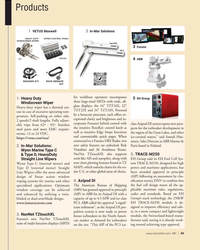 )
April 2024 - Marine News page: 43
)
April 2024 - Marine News page: 43system is now ready to power ty, in a more compact and lightweight 3. NavNet TZtouchXL Furuno’s new NavNet TZtouchXL future icebreakers in the North Ameri- module, the Switzerland-based manu- can market as demand for icebreakers facturer said, noting it is already work- suite of multi-function
-
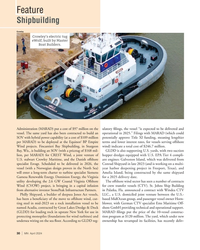 )
April 2024 - Marine News page: 30
)
April 2024 - Marine News page: 30Esvagt. Scheduled to be delivered in 2026, the Conrad Shipyard in late 2023 (and is working on a multi- vessel (with a Norwegian design proven in the North Sea) year harbor deepening project in Freeport, Texas), and will enter a long-term charter to turbine specialist Siemens Amelia Island, being constructed
-
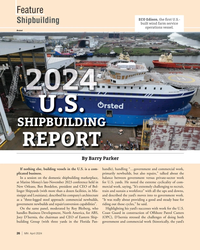 )
April 2024 - Marine News page: 26
)
April 2024 - Marine News page: 26,” he said. On the same panel, moderated by Roy Bleiberg, who Highlighting his yard’s successes with work for the U.S. handles Business Development, North America, for ABS, Coast Guard in construction of Offshore Patrol Cutters Joey D’Isernia, the chairman and CEO of Eastern Ship- (OPC), D’Isernia stressed
-
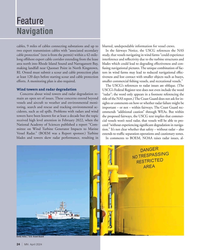 )
April 2024 - Marine News page: 24
)
April 2024 - Marine News page: 24“could experience long offshore export cable corridor extending from the lease interference and re? ectivity due to the turbine structures and area north into Rhode Island Sound and Narragansett Bay, blades which could lead to degrading effectiveness and con- making landfall near Quonset Point in North
-
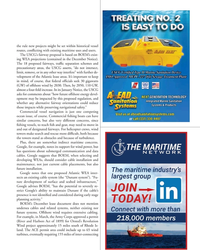 )
April 2024 - Marine News page: 23
)
April 2024 - Marine News page: 23the rule new projects might be set within historical vessel routes, con? icting with existing maritime uses and users. The USCG’s fairway proposal is based on BOEM’s exist- ing WEA projections (contained in the December Notice). The 18 proposed fairways, traf? c separation schemes and precautionary
-
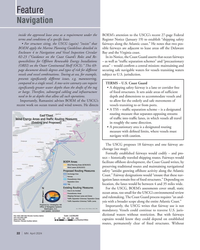 )
April 2024 - Marine News page: 22
)
April 2024 - Marine News page: 22Feature Navigation inside the approved lease area as a requirement under the BOEM’s attention to the USCG’s recent 27-page Federal terms and conditions of a speci? c lease. Register Notice (January 19) to establish “shipping safety • For structure siting, the USCG (again) “insists” that fairways along
-
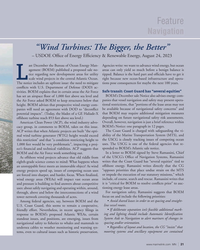 )
April 2024 - Marine News page: 21
)
April 2024 - Marine News page: 21Feature Navigation “Wind Turbines: The Bigger, the Better” – USDOE Of? ce of Energy Ef? ciency & Renewable Energy, August 24, 2023 ast December the Bureau of Ocean Energy Man- Agencies write: we want to advance wind energy, but ocean agement (BOEM) published a proposed sale no- areas can only yield so
-
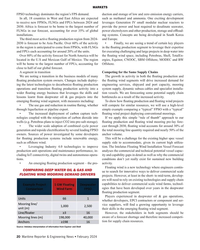 )
February 2024 - Maritime Reporter and Engineering News page: 20
)
February 2024 - Maritime Reporter and Engineering News page: 20FPUs each accounting for around 20% of the units. for executing challenging and large projects in deep water into Over 80% of the activity forecast for North America will be the ? oating wind space, including Petrobras, Shell, TotalEn- located in the U.S and Mexican Gulf of Mexico. The region ergies,
-
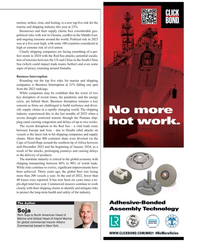 )
February 2024 - Maritime Reporter and Engineering News page: 13
)
February 2024 - Maritime Reporter and Engineering News page: 13with their shipping clients to identify and mitigate risks to protect the long-term health and safety of the industry. The Author Soja Rich Soja is North American Head of Marine and Global Head of Inland Marine for global commercial insurer Allianz Commercial based in New York. MR #2 (1-17).indd
-
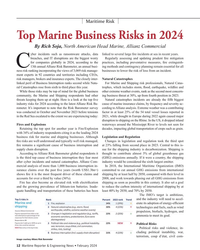 )
February 2024 - Maritime Reporter and Engineering News page: 12
)
February 2024 - Maritime Reporter and Engineering News page: 12Maritime Risk Top Marine Business Risks in 2024 By Rich Soja, North American Head Marine, Allianz Commercial yber incidents such as ransomware attacks, data linked to several large ? re incidents at sea in recent years. breaches, and IT disruptions are the biggest worry Regularly assessing and updating
-
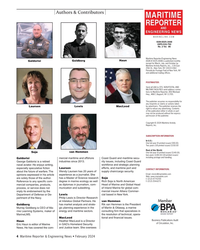 )
February 2024 - Maritime Reporter and Engineering News page: 4
)
February 2024 - Maritime Reporter and Engineering News page: 4. has a Master of Science research Soja t: (212) 477-6700 f: (212) 254-6271 Reference to any speci? c com- degree in marine ecology as well Rich Soja is North American mercial companies, products, as diplomas in journalism, com- Head of Marine and Global Head process, or service does not munication and
-
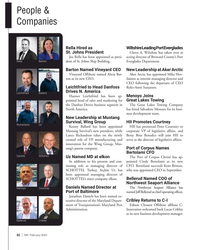 )
February 2024 - Marine News page: 42
)
February 2024 - Marine News page: 42has been ap- Great Lakes Towing pointed head of sales and marketing for the Danfoss Drives business segment in The Great Lakes Towing Company North America. has hired Salvadore Menoyo for its busi- ness development team. New Leadership at Mustang Survival, Wing Group HII Promotes Courtney Richardson
-
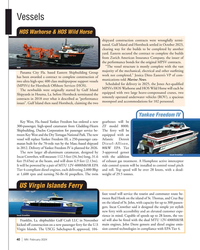 )
February 2024 - Marine News page: 40
)
February 2024 - Marine News page: 40Vessels HOS Warhorse & HOS Wild Horse shipyard construction contracts were wrongfully termi- nated. Gulf Island and Hornbeck settled in October 2023, clearing way for the builds to be completed by another yard. Eastern secured the contract to complete the builds from Zurich American Insurance Company
-
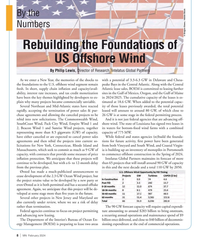 )
February 2024 - Marine News page: 8
)
February 2024 - Marine News page: 8capacity of the leases is es- plain why many projects became commercially unviable. timated at 18.6 GW. When added to the potential capac- Several Northeast and Mid-Atlantic states have reacted ity of those leases previously awarded, the total potential rapidly, accepting the termination of power
-
 )
January 2024 - Marine Technology Reporter page: 56
)
January 2024 - Marine Technology Reporter page: 56, which represents 60GW of potential;. as the issues with very deep waters on the West Coast of the Asia Paci? c and its 81GW of potential; and then North Amer- United States where we have one kilometer or more. [The ica, where we’re talking about 31GW,” Ortega said. third generation] is innovation in
-
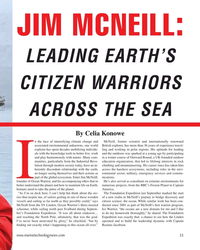 )
January 2024 - Marine Technology Reporter page: 35
)
January 2024 - Marine Technology Reporter page: 35ries that inspire me, of sailors getting in one of these wooden of a new realm in McNeill’s journey to bridge discovery and vessels and sailing as far north as they possibly could,” says citizen science: the ocean. While similar work has been con- McNeill from the SV Linden, Ocean Warrior’s three-masted
-
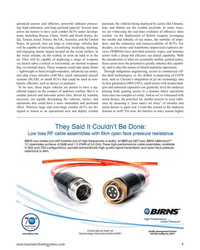 )
January 2024 - Marine Technology Reporter page: 9
)
January 2024 - Marine Technology Reporter page: 9ways, actors are known to have such combat AUVs under develop- we are witnessing the real-time evolution of offensive mine ment, including Russia, China, North and South Korea, In- warfare via the deployment of hybrid weapons leveraging dia, Taiwan, Israel, France, the UK, Australia, and the United the stealth
-
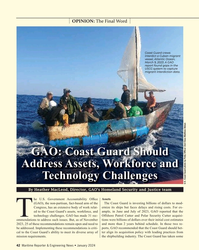 )
January 2024 - Maritime Reporter and Engineering News page: 42
)
January 2024 - Maritime Reporter and Engineering News page: 42OPINION: The Final Word Coast Guard crews interdict a Cuban migrant vessel, Atlantic Ocean, March 9, 2023. A GAO report found gaps in the USCG system to capture migrant interdiction data. GAO: Coast Guard Should Address Assets, Workforce and Technology Challenges U.S. Coast Guard photo by Petty
-
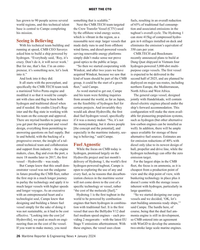 )
January 2024 - Maritime Reporter and Engineering News page: 26
)
January 2024 - Maritime Reporter and Engineering News page: 26, and group, it could be the start of a green deployed on major sea routes, including speci? cally the CMB.TECH team took ? eet,” said Campe. northern Europe, the Mediterranean, a marinized Volvo Penta engine and As word started to get out, Campe North Africa and West Africa. modi? ed it so
